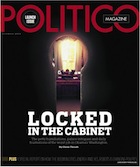
Politico launched its magazine Thursday, with features on the dramas of Obama’s cabinet, Tim Gunn and Ada Calhoun on Beltway fashion and an eerie photo essay about America’s abandoned malls.
Editor-in-chief Susan Glasser introduces the magazine with a look at what Politico itself has done during the past seven years, aiming “to drive the Washington conversation with an urgency, smarts and digital-era metabolism that has helped reinvent political news.”
Politico Magazine, however, plans to take a deeper, and longer, look at stories, Glasser writes, that don’t always make it in the daily deluge of news.
Perhaps most importantly, the magazine aims to fill a dangerous vacuum in the rapidly transitioning world of journalism, with too few really big takes on big subjects holding leaders in Washington and beyond accountable, as news organizations retrench, cut back or find themselves distracted by the all-too-real imperatives of just staying in business.
In June, Dylan Byers wrote about Glasser’s new role, and the work she’d done previously at Foreign Policy Magazine. In their memo to staff, Jim VandeHei and editor-in-chief Jim Harris look back at the life stages of Politico so far, and where they hoped Glasser would help take them next — adding magazine-style journalism to Politico, as well as adding “vitality and impact to POLITICO’s daily report by marshaling the best outside contributors to produce analysis, argument and first-person perspectives on the news of the day.”
We imagine this content as melding the best of several traditional platforms – newspaper op-ed pages, for instances, or Sunday Outlook and Week in Review sections – and revitalizing them for contemporary times. The key to doing this successfully is to have a relentless editorial mind setting the agenda, with a creative sensibility for driving the conversation in Washington and beyond.
In October, Michael Calderone wrote in Huffington Post about the magazine’s growing and notable bench, including moving Politico’s Glenn Thrush over to the magazine, and adding Jason Zengerle, who contributed to GQ and New York Magazine.
Long-form has never been a part of Politico’s DNA. Since its 2007 launch, Politico excelled in breaking news and quickly producing analytical takes in an effort to “drive the conversation,” as its editors say. During my days at Politico, the emphasis was clearly on churning out 400-word blog posts than spending weeks crafting a 4,000-word feature. But while Politico can be expected to continue competing hard for politics and policy scoops, its editors now hope to add another weapon to the arsenal: high-impact, magazine-style reporting.
The print edition of the new magazine comes out Friday, and new work will be added to the magazine’s site daily.







